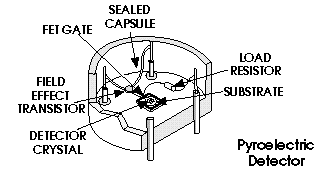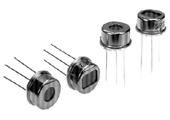

Advantages:
can be used over a wide range of wavelengths and can operate at room
temperature
Disadvantages:
slow response time (in the milliseconds) and low sensitivity
Thermocouple
A thermocouple is a type of thermal detector that places two
different metals (e.g. bismuth and antimony together). When the metals
are heated by IR radiation, a small voltage, proportional to the temperature
at the junction between the 2 metals, is sent out (the Peltier effect).
Several thermocouples connected in series make up a thermopile.
Advantages of a thermopile:
-adequate sensitivity
-flat spectral response
Disadvantages of a thermopile:
-suffer from temperature drift (the reference portion of the detector
is constantly absorbing heat)
Pyroelectric Detector
A pyroelectric detector is composed of a noncentrosymmetrical crystal
that has an internal electrical field along its polar axis. As IR radiation
is applied there is a change in the polarization caused by an alteration
of the crystal lattice of the crystal. By connecting 2 electrodes
to the crystal, the pyroelectric detector can act as a capacitator. Note:
the effects depend on the rate of temperature change, not the temperature
change itself. The detector will also ignore the effects of background
radiation.
Pyroelectric detectors are commonly used in FTIR spectrometers.


Link List:
http://poe.acc.virginia.edu/~roa2s/IR_Detectors_Thermal.html
http://www.intl-light.com/handbook/ch10.html
http://www.everettinfrared.com/detector.htm
http://www.laurin.com/DataCenter/Dictionary/CD/dp/pyroinde.htm
http://www.laurin.com/DataCenter/Dictionary/CD/dt/thermoco.htm
http://www.egginc.com/bin/webmate/egg/page/egg/show_a_prod/Products/Opto|105_203
http://www3.mediagalaxy.co.jp/smm/tech/b_2_5e.html
http://www2.omega.com/techref/tctables/kf-2.html
look up:
Peltier effect.
Encyclopedia of Industrial Chemistry:
http://www.wiley-vch.de/contents/ullmann/index.html